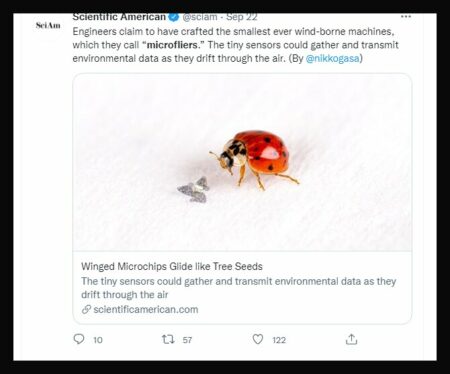|
Getting your Trinity Audio player ready...
|

The world’s smallest microchip microflier has just been announced. The new technology was officially announced in an article on Nature on Sept. 22, 2021. The developers were inspired by wind-dispersed seeds when they designed the winged microchips.
These tiny devices are no bigger than a grain of sand and can be used to monitor things such as air pollution and the spread of airborne diseases.
The microfliers were developed by engineers at Northwestern University in Evanston, Illinois. They are being dubbed as the smallest-ever human-made flying structures.

Developers designed the microchip devices without a motor. Being inspired by the helicopter-like seed of maple trees — the samara fruit. They created the microfliers with optimized aerodynamics so that “as these structures fall through the air, the interaction between the air and those wings cause a rotational motion that creates a very stable, slow-falling velocity,” according to John A Rogers — lead developer of the devices and professor of materials science and engineering, biomedical engineering, and neurological surgery at Northwestern University.
He further stated that the design “allows these structures to interact for extended periods with [the] ambient wind that really enhances the dispersal process.”
Once released the tiny microchips would be scattered by the wind. Then the devices would be able to sense their surrounding environment and collect data. These microfliers could then potentially monitor for contamination, track diseases, and surveil populations, according to the scientists who developed the microchips.
The designers can see the microchip microfliers becoming part of “large, distributed collections of miniaturized, wireless electronic devices.” This means they could look like a swarm while deployed.
Back in March, Kevin Chen — an assistant professor at the Massachusetts Institute of Technology — and his team announced they had developed a new microdrone. This device is almost as small as a mosquito. The new microchip microfliers are much smaller in comparison.
Potentially these new microchip devices could help researchers study and understand the way some diseases spread.
Written by Sheena Robertson
Sources:
NPR: Don’t Swat This Bug. It Might Be A Robot On A Rescue Mission; by Avery Keatley, Noel King, and Steve Inskeep
Nature: Three-dimensional electronic microfliers inspired by wind-dispersed seeds; by Kim, B.H., Li, K., Kim, JT. et al.
NPR: Flying Microchips The Size Of A Sand Grain Could Be Used For Population Surveillance; by Scott Neuman
Top and Featured Image Courtesy wolf4max’s Flickr Page – Creative Commons License



